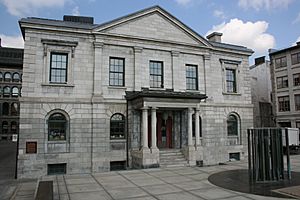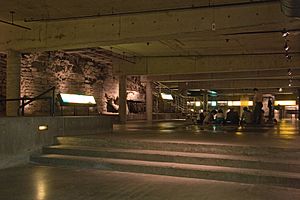Pointe-à-Callière Museum facts for kids
| Pointe-à-Callière, Musée d'archéologie et d'histoire de Montréal | |

View of the Pointe-à-Callière complex
|
|
| Established | 1992 |
|---|---|
| Location | Old Montreal, Ville-Marie, Montreal, Quebec, Canada |
| Type | Archaeology and History museum |
| Visitors | 353,503 (2011) |
| Architect | Dan Hanganu |
| Public transit access | |
The Pointe-à-Callière Museum is a special place in Old Montreal, Quebec, Canada. It's a museum of archaeology and history. This means it explores the past by studying old objects and places.
The museum opened in 1992. This was part of the big celebrations for Montreal's 350th birthday. It shows how different cultures lived together in the Montreal area. You can learn about the First Nations people. You can also see how the French and British influenced the land. The museum site itself is a National Historic Site. It has been recognized as Montreal's birthplace since 1924.
Many people visit the museum each year. Over 350,000 visitors come to explore its exhibits. Since it opened, millions of people have learned about history here. The museum has won many awards. These awards are for its amazing displays and educational programs. It is connected with other important museum groups in Canada.
The museum complex is made up of several cool parts. It includes three archaeological sites. There's also Montreal's first Catholic cemetery. You can see an old sewer system and an archaeological crypt. A historic building, the former Youville Pumping Station, is also part of it. The museum has over a million historical objects. The main museum building stands where the Royal Insurance Building once was. This building was also Montreal's second Customs House.
Contents
Discovering Montreal's Past
The Pointe-à-Callière Museum opened its doors in 1992. The first idea was to show an old sewer and the remains of a market. This market was also where the Parliament of the United Province of Canada met.
New Discoveries and Future Plans
Recent archaeological digs have found exciting new things. They uncovered parts of Fort Ville-Marie. This was an early settlement. They also found the home of Governor Louis-Hector de Callière. These discoveries are planned to be shown in a future expansion. This expansion will also show the Little Saint-Pierre River. This river was turned into a canal by the William sewer. The remains of St. Anne's Market will also be on display. This market was home to the Parliament of the United Province of Canada from 1844 to 1849. Visitors will be able to enter a new exhibition hall. This hall will be used for international exhibits. These exhibits will focus on ancient civilizations and their cultures.
Traveling Exhibitions
The museum has shared its knowledge with others. In 1996, its first traveling exhibit was shown. It was called Water In, Waste Out. This exhibit went to other museums in Quebec and France. In 1997, students showed their art at an Art and Archaeology exhibit. An exhibit called 1690: The Siege of Québec... The Story of a Sunken Ship has traveled since 2000. Another exhibit, France / New France, has toured internationally. The museum also has an exhibit about underground Montreal. This is part of a cultural path in the city's underground tunnels.
Exploring the Museum Complex

The Pointe-à-Callière Museum is built over many important historical sites. These sites show major parts of Montreal's history. Some of the old remains found during construction are still there. They are part of the museum's permanent displays. The museum was built on tall supports. This was done to protect the old discoveries underneath.
The main entrance of the museum is in a very important spot. It's where the first French settlers landed in 1642. These settlers included Paul de Chomedey, Sieur de Maisonneuve and Jeanne Mance.
Parts of the Museum Complex
- L'Éperon building
- Old Custom House - This building was built in 1836.
Museum Exhibits and Activities

The museum shows archaeological remains from every time period in Montreal's past. The sites it protects have one of the largest collections of old objects in Canada. The museum staff are experts. They research, protect, and share information about archaeology and history. They work with universities to study the city's past. The museum also has objects and documents given by local people. These help tell the story of the city's buildings and industries.
Permanent Exhibitions
The museum has many exhibits you can always see. These include:
- 1701 - The Great Peace of Montréal
- Archaeo-Adventure
- Building Montréal
- Crossroads Montréal
- Memory Collector
- Pirates or privateers?
- Where Montréal Began
- Yours Truly, Montréal multimedia show
Besides its permanent displays, the museum has hosted many temporary exhibits. These exhibits cover local and international archaeology and history. They also explore culture and artistic creativity. The museum offers educational programs for schools and the public. These programs teach about archaeology and history. The museum also hosts musical performances and theatre shows. They have lectures and debates. The museum works with Native and cultural groups. For example, in 2001, they worked with aboriginal groups. This was for the 300th anniversary of the 1701 Great Peace of Montreal.
Past Temporary Exhibitions
The museum has featured many exciting temporary exhibits over the years. Here are some of them:
- 2014-2015: The Greeks: Agamemnon to Alexander the Great
- 2014: Marco Polo: an epic Journey
- 2013-2014: Lives and Times of the Plateau
- 2013-2014: The Beatles in Montréal
- 2013: The Tea Road
- 2012-2013: Samurai: The Prestigious Collection of Richard Béliveau
- 2012: The Etruscans: An Ancient Italian Civilization
- 2011-2012: Colors of India
- 2011: To Your Health, Cesar! Wine with the Gauls
- 2010-2011: St.Catherine Street makes the Headlines
- 2010: Easter Island: An Epic Voyage
- 2010: 100 years underground
- 2010: Discovering legends with Jean-Claude Dupont
- 2009-2010: Pirates, Privateers and Freebooters
- 2008-2009: Costa-Rica: Land of wonders!
- 2008: France, New France: birth of a French people in North America
- 2007-2008: 1837•1837, Rebellions, Patriotes vs Loyalists
- 2007: First Nations, French Royal Collections
- 2006-2007: St. Lawrence Iroquoians, Corn People
- 2006: Japan
- 2005-2006: Jules Verne, Writing the Sea
- 2005: Encounters in Roman Gaul
- 2004-2005: Old Montréal in a New Light
- 2004: Oceania
- 2003-2004: Dreams and Realities Along the Lachine Canal
- 2003: Archaeology and the Bible – From King David to the Dead Sea Scrolls
- 2002-2003: Varna – World's First Gold, Ancient Secrets
- 2002-2003: A Collection from the Varna Museum, Bulgaria
- 2002: Saint-Laurent, Montréal's "Main”
- 2001–2002: Mysteries of the Moche of Peru
- 2001: 1701 – The Great Peace of Montréal
- 2000–2001: Africa Musica!
- 2000–2001: Exploring a Collection from the Museo Pigorini
- 2000: 1690: The Siege of Québec... The Story of a Sunken Ship
- 1999–2000: Treasures from the South of Italy — Basilicata, Land of Light
- 1999: Montréal, by Bridge and Crossing
- 1998–1999: Art and Archaeology: Young Artists from Lyon at the Museum
- 1998–1999: Treasures from the Ukrainian Steppes
- 1998: The Ravages of Time: Restoring Heritage Objects from France
- 1998: Crucifixion: Unique Archaeological Evidence from Jerusalem
- 1997–1998: Bannock, Baguette, Bagel – Montréal Bread
- 1997: Abitibiwinni, 6,000 Years of History
- 1997: Art and Archaeology
- 1996–1997: Ancient Cyprus: 8,000 Years of Civilization
- 1996: Dream Merchants. The Emergence of Cinema in Quebec
- 1996: Water In, Waste Out. The History of Aqueducts, Water Mains and Sewers in Montréal
- 1995–1996: Window Stories
- 1995: The Port as Seen by Pierre Bourgault, Gilles Vigneault and Helmut Lipsky
- 1994–1995: Bones and Bottles — Fragments of History
See also
 In Spanish: Pointe-à-Callière para niños
In Spanish: Pointe-à-Callière para niños
- Archaeology in Quebec


